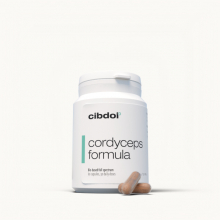Is cordyceps good for fatty liver?
Last updated:
Published:
Ever heard of cordyceps? If not, you're in for a treat. This medicinal mushroom, especially the Cordyceps militaris variety, has been making waves in the health community. Now let's get down to brass tacks - fatty liver disease, also known as hepatic steatosis or hepatosteatosis. Alarmingly common, this condition, often linked to livers damaged by poor dietary choices and excessive alcohol consumption, can escalate to alcoholic steatohepatitis if not properly managed.
Contents:
Here's the kicker - cordyceps could potentially be a game-changer for livers, particularly in their hepatoprotective activity! Preliminary research suggests that these funky fungi might help combat hepatosteatosis (that's science-speak for fatty liver), potentially aiding hepatocytes and improving hepatic antioxidant status. So buckle up as we delve into the world of cordyceps and its potential impact on fatty liver disease.

Animal Studies: Cordyceps Impact on Liver
Cordyceps, a type of fungi known for its medicinal properties, has been the subject of numerous animal studies. Researchers have been keen to explore its potential benefits for liver health, specifically the health of hepatocytes. One area that's sparked interest is whether cordyceps is good for fatty liver, also known as hepatosteatosis.
Key Studies and Findings
Numerous research conducted on aged rats have demonstrated encouraging outcomes. For instance, in one study, these rodents with induced liver damage, particularly in their hepatocytes, were administered cordyceps. After a certain period, livers were sampled and scrutinized. The results? A significant reduction in hepatosteatosis, or liver fat, was observed.
In another study examining the impact of cordyceps on livers, specifically focusing on hepatosteatosis, rats were used as an animal model. After administering cordyceps extracts, enhancements in various markers such as glutathione, indicating healthy liver function and reduced hepatic steatosis, were observed.
It's not just about hepatosteatosis, or fatty livers, either. Some animal models, particularly obese mice, have hinted at potential cancer effects too. In these studies, cordyceps, a type of fungi, seemed to inhibit the growth of certain types of cancer cells in the liver. Additionally, the presence of glutathione was observed.
Limitations and Future Directions
While these results, available on Google Scholar, are encouraging, it's crucial to remember that they're based on animal cells models - we can't immediately apply them to human blood cells without further research.
Human trials are needed to confirm whether these benefits translate into real-world applications for people with hepatic steatosis, hepatosteatosis, or other forms of liver disease. It would also be useful to understand how dosage and effects might vary between species and with supplementation.
Moreover, while the safety profile of cordyceps appears favorable based on these studies (with no adverse effects reported), comprehensive safety assessments in humans are still required. These assessments could involve research on cells and blood, utilizing resources such as Google Scholar for a broader understanding.
Safety Profile
The safety profile of cordyceps, a food item rich in dietary fiber, has been assessed in several research studies including those found on Google Scholar. In general, it seems safe for consumption with minimal side effects reported across different doses and durations.
However, this doesn't mean that food, even with its antioxidant effects, is completely risk-free - especially when consumed outside recommended dosages or by individuals with specific health conditions like allergies or immune disorders. This stands true even for samples of food items.
So there you have it! That's a quick dive via Google Scholar into what we know so far about the effects of cordyceps on livers, specifically in relation to hepatosteatosis, based on animal studies. Remember though - while this science is exciting and often promising, it's always best to consult your healthcare provider before starting any new supplement regimen.
Serum Analysis: Cordyceps Effect on Lipids
Cordyceps, a type of fungus known for its pharmacological effects, has been studied extensively for its role in influencing lipid profiles in blood serum and livers. The beneficial effects of cordyceps, combined with a high-fiber diet, have been linked to several health benefits, including the potential to reduce the risk of hepatosteatosis, a form of fatty liver disease.
Cordyceps and Lipid Profiles
Research indicates that cordyceps can significantly alter serum triglyceride levels, potentially impacting fatty liver disease. A study conducted on rats found that a fat diet enriched with cordyceps reduced serum triglyceride and total lipid contents, showcasing its antioxidant effects. It also lowered low-density lipoprotein (LDL) levels while increasing high-density lipoprotein (HDL) levels.
The antioxidant activity of cordyceps, a protein-rich food, is believed to play a crucial role in these effects. Antioxidants are substances that can prevent or slow damage to cells caused by free radicals or unstable molecules that the body produces as a reaction to environmental and other pressures.
Impact on Fatty Liver Risk
High serum triglyceride and LDL levels are associated with an increased risk of hepatosteatosis, a type of fatty liver disease. By reducing these lipids in our livers, cordyceps, a powerful antioxidant, may contribute to lowering this risk through a balanced diet.
For example:
Lowering LDL: Known as 'bad cholesterol', high LDL levels can lead to fat accumulation in the livers, a condition known as hepatosteatosis. This lipid overload can further trigger insulin resistance.
HDL and Lipid Balance: Known as the 'good cholesterol', HDL aids in removing other forms of cholesterol, including lipids associated with fatty liver disease or hepatosteatosis, from your bloodstream. It also plays a role as an antioxidant.
Reducing Triglycerides and Lipids: These are types of fat found in your blood and diet. High levels can contribute to hardening of the arteries or thickening of the artery walls, which increases the risk of stroke, heart attack, and heart disease. They can also lead to insulin resistance and hepatosteatosis.
Beyond Just The Liver
Balanced lipid levels aren't just vital for liver health, particularly in preventing hepatosteatosis; they're essential for overall well-being too. High levels of total lipids, often a result of a fat diet, increase the chances of developing cardiovascular diseases such as heart attacks and strokes. Understanding the effects of such diets and the role of antioxidants can be crucial.
Lower lipid peroxide levels, a type of antioxidant, have been associated with improved metabolic health parameters like serum glucose levels, which are linked to insulin production, and serum alt activities - both critical indicators for conditions like diabetes and liver diseases respectively. These are especially relevant when considering the effects of a high fat diet.
Role of Polysaccharides in Cordyceps Sinensis
So, what's the big deal about polysaccharides and insulin? These are complex carbohydrates and proteins made up of sugar molecules and lipids. They're kind of like the body's fuel tank, providing energy, managing weight, and playing a crucial part in various bodily functions.
Now, let's delve into cordyceps sinensis. This little fungus, often researched on Google Scholar, is packed with crude polysaccharides that could prove beneficial for your liver, and potentially protein regulation. Studies on mice have indicated possible benefits to insulin levels as well. Here's how.
Liver-loving Benefits
Anti-inflammatory Action: Inflammation can be a real pain, especially for your liver. The polysaccharide content in cordyceps sinensis might help keep this at bay by reducing inflammation.
Antioxidant Properties: Oxidative stress is no joke! It can lead to serious damage to your cells. But don't worry - the antioxidant properties of these polysaccharides may help protect against this cell damage.
However, it's crucial to note that additional research on Google Scholar is required to fully comprehend the effects and their overall impact on NAFLD (Non-Alcoholic Fatty Liver Disease), including how these mechanisms interact with insulin.
More Research Needed
While there are promising signs on Google Scholar that cordyceps sinensis could be beneficial for NAFLD (Non-Alcoholic Fatty Liver Disease) due to its protein and polysaccharide content, we need more concrete evidence. Science isn't something you rush - it takes time, insulin-related studies, and rigorous testing to get definitive answers.
Is cordyceps good for fatty liver?
Cordyceps, a unique type of fungus, has been studied extensively for its potential health benefits. From studies on mice, it's clear that cordyceps positively impacts liver health and may aid in the fight against diseases like NAFLD. It works wonders in reducing lipid accumulation and enhancing liver functions, potentially due to the presence of beneficial proteins.
A thorough examination into serum protein analysis reveals the effect of cordyceps on lipids and insulin is impressive. It significantly reduces bad cholesterol levels while boosting the good ones. This balance, crucial in the treatment of fatty liver conditions, plays a vital role in managing non-alcoholic fatty liver disease (NAFLD).
One can't overlook the role of polysaccharides found in Cordyceps Sinensis or the impact of fenofibrate and insulin, either. These compounds, along with certain proteins, have shown to possess potent hepatoprotective properties which further strengthens the case for cordyceps, fenofibrate, and insulin being beneficial for fatty liver, or NAFLD.
In conclusion, evidence from Google Scholar suggests that cordyceps could be a game-changer for people dealing with NAFLD (Non-Alcoholic Fatty Liver Disease). However, more human studies are needed to fully understand its potential benefits and treatment side effects.
Now that you're armed with this info from Google Scholar, why not give cordyceps, a protein-rich extract, a shot as a treatment? Remember to consult your healthcare provider before starting any new supplement regimen.
FAQ
Is Cordyceps safe to consume?
Yes, generally Cordyceps is considered safe to consume as a treatment. However, it's always best to consult with your healthcare provider or check Google Scholar before starting any new supplement regimen like CSP or introducing serum into your routine.
Can I take Cordyceps daily?
Yes, you can take the Cordyceps extract as a daily treatment, but it's recommended to follow the dosage instructions provided by the csp or serum manufacturer or advised by your healthcare provider.
How long does it take for Cordyceps to work?
The effects of Cordyceps extract treatment may vary from person to person, and even in mice, depending on various factors such as individual health condition and consistency of use. This is supported by numerous studies available on Google Scholar.
Are there any side effects of consuming Cordyceps?
Some people, including mice used in studies, might experience mild side effects like nausea or diarrhea after consuming Cordyceps Militaris as a treatment for conditions like fatty liver disease. If these symptoms persist or worsen over time, immediately stop usage and consult with your healthcare provider.
Where can I buy high-quality Cordycep supplements?
You can find high-quality Cordyceps supplements at Cibdol. Always choose products from trusted brands like us that provide third-party testing results, and cross-verify with Google Scholar for additional assurance.















